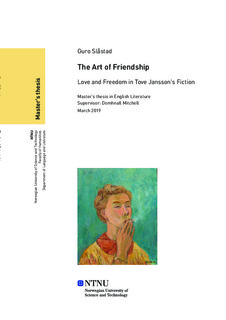| dc.description.abstract | While Tove Jansson’s Moomin books have been an important part of Anglophone popular culture since their translation into English in the 1950s, interest in her life and wider oeuvre has been renewed in the last decades through TV adaptations, reissues, translated biographies, a BBC TV documentary as well as new translations of her relatively unknown fiction for adults. In 2017, a retrospective exhibition of her visual work was held at Dulwich Picture Gallery in London, aiming to reintroduce her as a versatile and highly talented artist. This latest stage of the author’s Anglophone reception can be viewed as emblematic of a shift in the view of Jansson as an artist beyond the Moomins. The exhibition is key to this thesis, which also aims at displaying the depth and complexity of her life and fiction.
By employing a method that combines close reading and thematic analysis with biography, I show how Jansson used pictures and words as a means of working through her life’s seemingly irresolvable tensions. By tracing one such tension – the human longing for freedom and simultaneous need for love – in a novel marketed as adult fiction, Fair Play (1989), and in another marketed as children’s fiction, Moominpappa at Sea (1965), while also drawing on examples from her wider fiction, I demonstrate that her oeuvre should be viewed as a continuum despite its often being separated into categories of “adult” and “children’s” fiction. I thus use the age-neutral terms “Moomin” and “non-Moomin” fiction to distinguish between the works that are situated in the world of Moominvalley and those that have other settings, to indicate the continuity and development of this simple-seeming, yet deeply layered authorship. My comparative analysis shows that Jansson explores variations of the same themes and motifs across her fiction: i.e. the importance of having a personal space and purpose, as well as community and support; the island as a symbol of freedom and isolation; travelling as a strive for both physical and mental freedom; nature as a manifestation of the inner lives of characters; art and imagination as a refuge from society’s stifling expectations; and images of light and dark as representations of safety within the dangerous, the familiar within the unknown. In conclusion, I theorise over how her fiction might speak differently to children and adults by looking briefly at the turning-point of the Moomin saga, Moominland Midwinter (1957), and suggest that categorisations of her fiction relate more to the reader than the writer. Though employing biography is interesting and relevant in helping to explain why the tension between love and freedom was a pressing matter to Jansson as a twentieth-century female artist, my analysis shows that her fiction stands on its own: what makes her fiction appeal to readers of all ages is that it shows us what it is like to be human. | |
